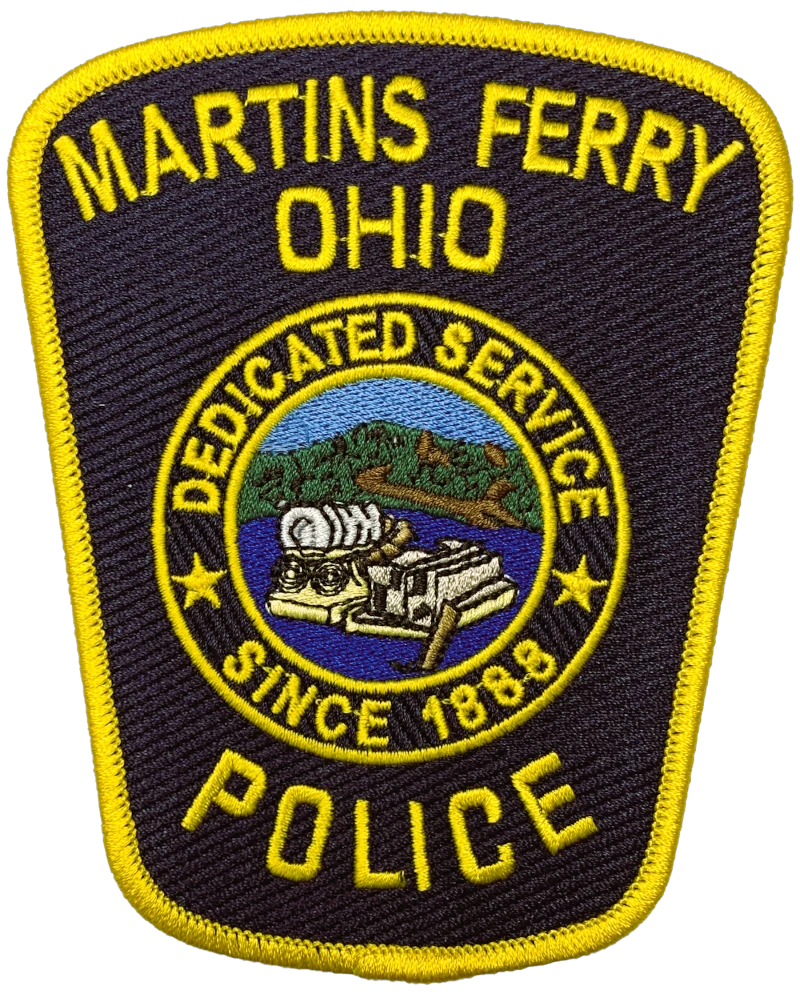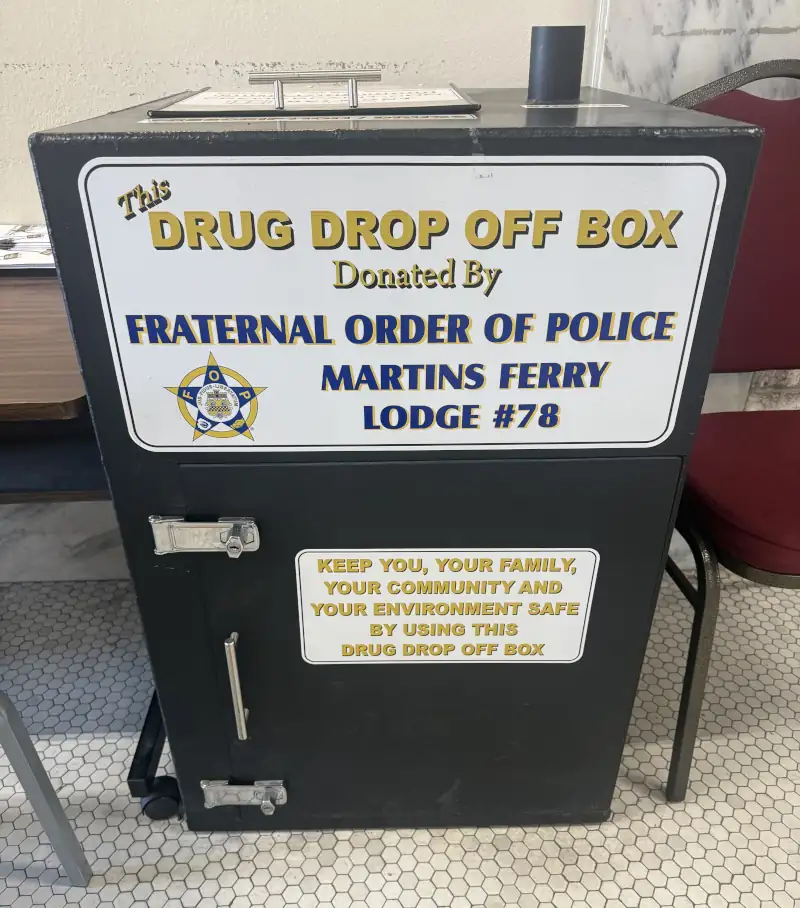Police Department
If you have an emergency, please dial 911!
For non-emergency assistance and question, please call us at 740-633-2121.
Vincent West
Chief of Police
City of Martins Ferry
Office: 740-633-2121
Fax: 740-633-0634
Email: vwest@martinsferryoh.gov
To contact the Police Department by email, select the email address below for the officer or staff you wish to reach. Please be sure to include a phone number(s) or other contact information within your email message if you wish to receive a response from the Police Department staff.
For public records and FOIA requests contact or email Sgt. Mika Armstrong.
For questions about accident reports contact or email Sgt. Mika Armstrong.
All Police Department staff may be reached by calling 740-633-2121.
| Title | Name | |
| Sergeant | Mika Armstrong | marmstrong@martinsferryoh.gov |
| Patrolman | Cory Barrett | cbarrett@martinsferryoh.gov |
| Patrolman | Zach Cole | zcole@martinsferryoh.gov |
| Patrolman/FTO | Fred Owens | fowens@martinsferryoh.gov |
| Patrolman | Robert Shreve | rshreve@martinsferryoh.gov |
| Patrolman | Codi Klaus | cklaus@martinsferryoh.gov |
| Patrolman/FTO | Kade Carpenter | kcarpenter@martinsferryoh.gov |
| Patrolman | Jon Young | jyoung@martinsferryoh.gov |
| Patrolman | Chad Nixon | cnixon@martinsferryoh.gov |
| Patrolman | Timothy Skinner | tskinner@martinsferryoh.gov |
| Auxiliary Officers | ||
| Patrolman/SRO | Jerry Murphy | jmurphy@martinsferryoh.gov |
| Patrolman/SRO | Vernon Trigg | vtrigg@martinsferryoh.gov |
| Patrolman | Brenton Boston | bboston@martinsferryoh.gov |
| Patrolman | Nico Bumba | nbumba@martinsferryoh.gov |
| Patrolman | George Shreve | gshreve@martinsferryoh.gov |
Drug Drop Off
Drug Drop Off Box available inside of the Martins Ferry City Building
The intention of this service is to dispose of dangerous prescribed chemicals or narcotics that may cause harm if accidentally ingested or put into nature. Over the counter items such as Aspirin, Vitamins, Cold and Flu medications, and the like can be disposed on your own.
How to Dispose of Unwanted MedicationsMayor’s Court
Mayor’s Court fines can now be paid online using the link below.
Mayor’s Court Online PaymetsReports and Forms
A Brief History of the Police Department
Law enforcement has existed in various forms in Martins Ferry since the city’s incorporation in 1865. In fact it was in the same year that the city adopted the “Marshal System”.
Little is known regarding the first Marshals, however a consistent history is available via court dockets from the early “Justice of the Peace” system. In this system, Mayors took on the judicial responsibility of all matters prior to the creation of the modern county court system. Archived in the basement of the City Building are dockets spanning from 1878 to 1926.
These dockets show many changes in how Marshals operated. At times a single Marshal seemed to bear the burden of all matters. In 1880 for example, the department had a working Marshal in Robert Hanson, however several Constables worked under him. These included John B. Pyle, William Linn, Israel Phillips, and Nelson Madden.
Beside the ever-changing structure, turmoil was common throughout the late 1800’s. On May 10th, 1883 the Belmont Chronicle ran a story which read:
“The police force of Martin’s Ferry are on strike for $10 per week they now get $8. At council meeting last week that body was informed that they must have $10 or they would resign.”
Just as today, crime during the late 1800’s was a constant challenge for law enforcement. Suspects would flee via riverboat, or in one instance, hijacking a ferry-boat to escape capture. Riverboat thieves were a common problem, as well as outlawed sporting events such as cockfighting. Substance abuse issues at the time centered on “intoxicating liquors”, particularly during the prohibition era, as evidenced in court documents.
Many changes in the structure of the police occurred between the founding of the Marshal system until the modernization which occurred in 1888 when the department came under the control of the Safety Director. This system has remained intact with a set structure ever since.
A Betty Zane pamphlet written by members of the Martins Ferry Historical Society states:
“Police Department. Organized in 1888. Under control of the safety director. Personnel: Chief, two lieutenants, and twelve patrolmen; 21-31 years of age, at least 5’8” in height and 150 pounds in weight. Identification service instituted in the 1930’s.
Training: No specific training. Under civil service and chosen on the basis of rating on examination. Policing of dangerous school crossings done by augmented city uniform police appointed by the Mayor.
Salaries: Chief $440 per month, lieutenants $401.50 per month, and patrolmen $363 per month. Two weeks vacation with pay. Increase in salary is made by legislation of council. Under state retirement system.
Jail: Housed in the City Building. Juvenile offenses are referred to the probation officers. Juveniles may be sent to Boys’ Industrial School in Lancaster or Girls’ Industrial School in Delaware. Commitments of juveniles are made by the judges of Common Pleas or Probate Court. Mayor handles traffic and minor civil cases.”
Formally organized, the department began a period of technological modernization. An article from the March 29th, 1937 Wheeling Intelligencer highlights the addition of the fingerprint department. Notable in the article is Martins Ferry Police Department officer George Helt’s fingerprint lift of notorious “Baby Face” Nelson (Lester Gillis) for a crime committed in Jefferson County. This fingerprint lift was later credited for helping with his capture.
In an article from the Times Leader on August 21st, 1961, the trial of the department’s first radar detector for vehicle speed control occurred. The device was known then as a “radar speed timer.”
Fast forwarding to today, many of the names have changed, but the tendency for crime remains the same. Theft has always been a concern; however crimes have evolved to be more “high-tech” via computer identity theft and credit fraud. Riverboat chases have given way to modern vehicle pursuits, the flatboat exchanged for a Dodge Charger. Officer George Helt would be proud to see the evolution of fingerprinting with portable digitized scanners able to take prints from a suspect at the scene and compare them to known databases without a drop of ink.
The initial trial run of the radar was groundbreaking at the time. Today’s patrol cars are equipped with automatic license plate readers which can detect a stolen plate via a database as quickly as scanning an item at the grocery store. The scanners read the plate, either oncoming or passing, record it, photograph it, and check it in a fraction of a second.

